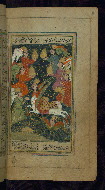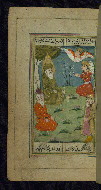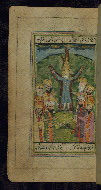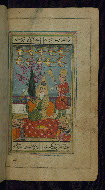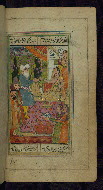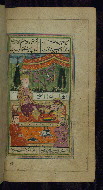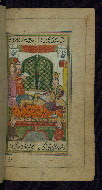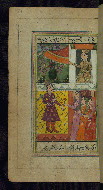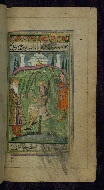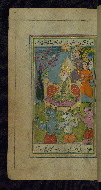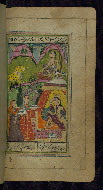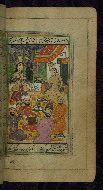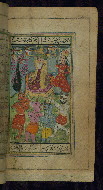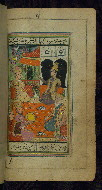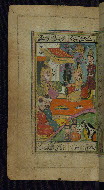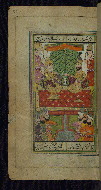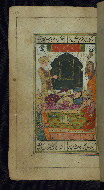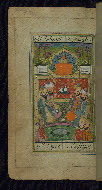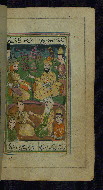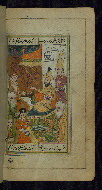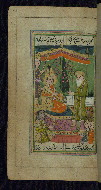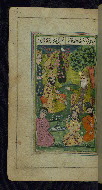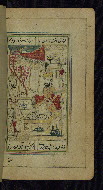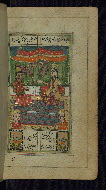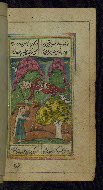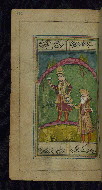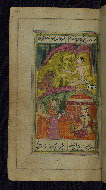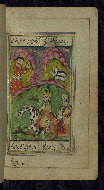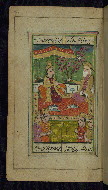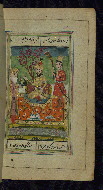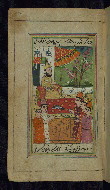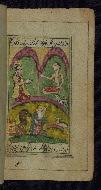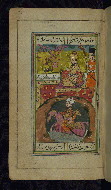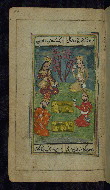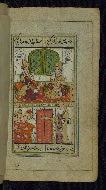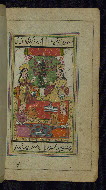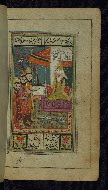Home > Digitized Walters Manuscripts
This document is a tranformation of a TEI P5 XML manuscript description incorporating images. If you have trouble reading special or non-Latin characters on this page, please make sure you have appropriate Unicode fonts installed and an up-to-date web browser.
Walters Ms. W.635, Collection of poems (divan)
Browse images (Browse images in a new window) | TEI in XML format
W.635
Collection of poems (divan)
Vernacular: ديوان حافظ
Authority name: Ḥāfiẓ, 14th cent.
As-written name: Shams al-Dīn Muḥammad Ḥāfiz al-Shīrāzī
Name, in vernacular: شمس الدين محمد حافظ الشيرازى
Note: Author dates preferred by cataloger: (fl. 8th century AH / 14th CE)
This is an illuminated and illustrated Collection of poems (dīvān) by Shams al-Dīn Muḥammad Ḥāfiz al-Shīrāzī (fl. eighth century AH / fourteenth CE), which was produced in India. According to the colophon, the manuscript was completed on the 19th Rajab 1202[?] AH / 1788[?] CE. It opens with a double-page illuminated incipit (fols. 1b-2a) with headpiece that introduces the preface (dībāchah) (fols. 1b-4b), followed by another double-page illuminated incipit with headpiece opening the main text of the Dīvān (fols. 5b-6a). The codex is decorated throughout with square and rectangular panels, as well as horizontal bands with floral decoration marking the end of odes, quatrains, or series of verses. There are forty-nine illustrations. The brown leather binding with medallion and pendants is contemporary with the manuscript.
19th Rajab 1202[?] AH / 1788[?] CE
India
Book
Literary -- Poetry
The primary language in this manuscript is Persian.
- Transliteration: tamma tamma tamām shud bi-tārīkh-i nūzdahum /1/ shahr-i Rajab al-murajjab sanat-i 1202[?] /2/
- Comment: Date uncertain (evidence of erasure of second digit)
Paper
Laid paper
Foliation: i+ 213+i
Catchwords: Written obliquely on versos
8.0 cm wide by 14.0 cm high
4.5 cm wide by 9.0 cm high
- Columns: 2
- Ruled lines: 14
- Framing lines in blue, red, gold, and green
- Title: Dīvān-i Ḥāfiẓ
- Author: Ḥāfiẓ, 14th cent.
- Incipit: حمد بيعد وثناى بيعد وسڀاس بيقياس...
- Text note: Main text of the Dīvān preceded by a preface (dībāchah) (fols. 1b-4b)
- Hand note: Written in black nastaʿlīq script
- Decoration note: Forty-nine illustrations; double-page illuminated incipit with headpiece introducing the preface; double-page illuminated incipit with headpiece introducing the main text; square and rectangular panels with floral decoration on text pages; framing lines in blue, red, gold, and green
fol. 1b:
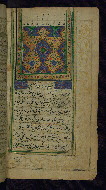
- Title: Incipit page with illuminated headpiece
- Form: Incipit; headpiece
- Label: This incipit page has an illuminated headpiece inscribed with the doxological formula (basmalah). It introduces the preface (dībāchah) of the work. There is gilt interlinear decoration with a flower and vine gilt border.
fol. 5b:
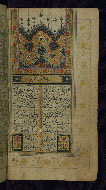
- Title: Incipit page with illuminated headpiece
- Form: Incipit; headpiece
- Label: This incipit page has an illuminated headpiece inscribed with the doxological formula (basmalah) introducing the initial verses of the Dīvān. There is gilt interlinear illumination and rectangular panels with floral motifs in the lower corners of the text area.
fol. 8b:
fol. 12a:
fol. 14a:
fol. 19b:
fol. 23b:
fol. 28b:
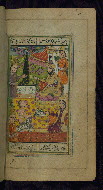
- Title: Comparison of two famous couples: Iyāz and Sultan Maḥmūd and Laylá and Majnūn
- Form: Illustration
fol. 33b:
fol. 38b:
fol. 43b:
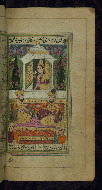
- Title: A beautiful girl and two gentlemen
- Form: Illustration
- Label: This illustration seems to depict the lower verse inscribed on the page indicting that it is not necessary to bring a candle to the gathering, as the beautiful face of the woman is illumination enough.
fol. 48a:
fol. 54a:
fol. 59b:
fol. 65a:
fol. 70b:
fol. 75b:
fol. 80b:
fol. 86b:
fol. 92a:
fol. 97a:
fol. 102b:
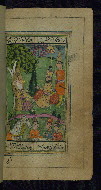
- Title: Alexander the Great, in search of the Fountain of Life, meets the prophet Khiḍr
- Form: Illustration
fol. 107a:
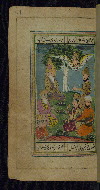
- Title: Jesus in the company of men and women
- Form: Illustration
- Label: This illustration seems to refer to the first couplet on the page: “Wine, like Jesus, gives life to dead bodies.”
fol. 113a:
fol. 119b:
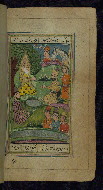
- Title: Alexander the Great, in search of the Fountain of Life, meets the prophet Khiḍr
- Form: Illustration
fol. 122a:
fol. 126b:
fol. 131b:
fol. 135a:
fol. 140a:
fol. 143b:
fol. 148b:
fol. 150b:
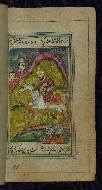
- Title: A man playing polo
- Form: Illustration
- Label: This illustration relates to the lower verse on this page: "The white horse of fortune became tame under you. You rode well into the field, so go forth and hit the ball."
fol. 153b:
fol. 156a:
fol. 161b:
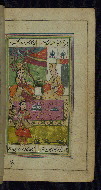
- Title: Gathering on a terrace
- Form: Illustration
- Label: This scene is supposed to go with the couplet "Considering what the women have done to Kay Kāvus and Kay Khusraw, do not put your faith in them."
fol. 171a:
fol. 178b:
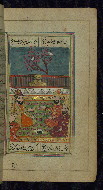
- Title: Figures seated around a magic bowl
- Form: Illustration
- Label: This scene refers to the first couplet on the page, referring to Jamshīd and his magic bowl (jām).
fol. 180b:
fol. 183a:
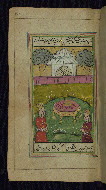
- Title: The empty throne and Jamshīd’s crown
- Form: Illustration
- Comment:
This scene is supposed to illustrate the verses of this page about the nothingness of this world and worldly things.
fol. 186a:
fol. 188b:
fol. 190b:
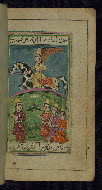
- Title: A beautiful girl (like an angel) on horseback followed by a crowd of admirers
- Form: Illustration
fol. 192a:
fol. 193b:
fol. 195a:
fol. 196b:
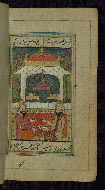
- Title: Two seated figures in discussion
- Form: Illustration
- Label: This scene refers to the verse about the passing of kings into oblivion, advising that one should not spend life without drink and merrymaking.
fol. 198a:
fol. 200b:
fol. 202b:
fol. 204b:
The binding is original.
Brown leather with inlaid medallions and pendants (no flap)
Walters Art Museum, 1931, by Henry Walters bequest
Richard, Francis. Catalogue des manuscrits persans. (Paris: Bibliothèque nationale, 1989), no. 272.
Principal cataloger: Gacek, Adam
Catalogers: Landau, Amy; Smith, Sita
Editor: Bockrath, Diane
Conservators: Jewell, Stephanie; Quandt, Abigail
Contributors: Barrera, Christina; Emery, Doug; Herbert, Lynley; Noel, William; Simpson, Shreve; Tabritha, Ariel; Toth, Michael B.; Valle, Chiara
The Walters Art Museum
Licensed for use under Creative Commons Attribution-NonCommercial-ShareAlike 3.0 Unported Access Rights, http://creativecommons.org/licenses/by-nc-sa/3.0/legalcode. It is requested that copies of any published articles based on the information in this data set be sent to the curator of manuscripts, The Walters Art Museum, 600 North Charles Street, Baltimore MD 21201.
